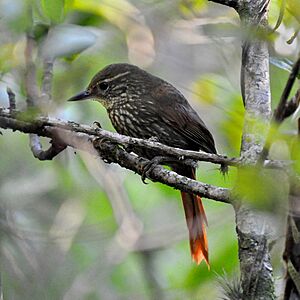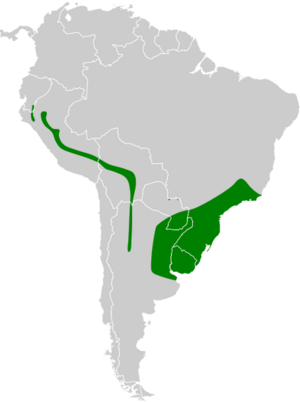Buff-browed foliage-gleaner facts for kids
Quick facts for kids Buff-browed foliage-gleaner |
|
|---|---|
 |
|
| Conservation status | |
| Scientific classification | |
| Genus: |
Syndactyla
|
| Species: |
rufosuperciliata
|
 |
|
The buff-browed foliage-gleaner (Syndactyla rufosuperciliata) is a small bird that belongs to the ovenbird family called Furnariidae. These birds are known for building interesting nests, sometimes shaped like ovens! You can find this special bird in several South American countries, including Argentina, Bolivia, Brazil, Ecuador, Paraguay, Peru, and Uruguay.
Contents
How Do Scientists Classify This Bird?
Scientists who study birds, called ornithologists, group animals to understand them better. The buff-browed foliage-gleaner's classification is still being studied. Different groups of scientists sometimes have slightly different ideas.
For example, the International Ornithological Committee and BirdLife International recognize four main types, or subspecies, of this bird:
- S. r. cabanisi
- S. r. oleaginea
- S. r. rufosuperciliata
- S. r. acrita
Another group, the Clements taxonomy, adds a fifth subspecies. However, for this article, we'll stick to the four main types.
Scientists have also looked at the bird's DNA to learn more. They found two main genetic groups: one lives in the Andes mountains, and the other lives in the Atlantic Forest. This discovery suggests that these two groups might even be considered separate species in the future!
What Does the Buff-browed Foliage-Gleaner Look Like?
This bird is about 17 to 18 centimeters (about 7 inches) long, which is roughly the size of a large sparrow. It weighs between 22 and 33 grams, which is about as much as a few quarters. It's a medium-sized bird with a thick beak that curves slightly upwards. Both male and female birds look the same.
The buff-browed foliage-gleaner gets its name from the light, yellowish-brown stripe above its eye, called a supercilium. This stripe goes all the way to the back of its neck. It also has a similar colored ring around its eye. The rest of its face is brownish with small buff marks.
Its head is a dull olive-brown, and its back, rump, and tail feathers are also plain olive-brown. Its tail is a dull reddish-brown, and its wings are a rich olive-brown.
Below, its throat is whitish with some brownish tips. Its chest is a buffy-whitish color with olive-brown edges on the feathers, making it look a bit scalloped. Its belly is olive-brownish with blurry whitish streaks. Its legs and feet are olive to brownish-gray. Young birds look similar to adults but have spots instead of streaks on their undersides.
The different subspecies have slight variations in their colors. For example, some might have a brighter stripe above the eye, a darker back, or more prominent streaks on their belly.
Where Does It Live?
The buff-browed foliage-gleaner lives in two main areas that are far apart from each other. This is called a "disjunct distribution."
Here's where you can find the different subspecies:
- S. r. cabanisi: Lives in the Andes mountains, from southern Ecuador down through Peru into Bolivia.
- S. r. oleaginea: Found in the Andes, from central Bolivia south into northwestern Argentina.
- S. r. rufosuperciliata: Lives in southeastern Brazil.
- S. r. acrita: Found in north-central Paraguay, southeastern Brazil, Uruguay, and northeastern Argentina.
In the Andes mountains, these birds prefer to live in evergreen forests and older secondary forests (forests that have regrown after being cut down). They often live where there is Chusquea bamboo. They are usually found at high elevations, between 1,300 and 2,500 meters (about 4,200 to 8,200 feet) above sea level.
In the southeastern parts of their range, they live in lowland tropical evergreen forests, gallery forests (forests along rivers), and secondary forests. Here, they can be found at elevations up to 2,000 meters (about 6,500 feet).
How Does It Behave?
Does It Move Around?
The buff-browed foliage-gleaner stays in its home territory all year long. It does not migrate to other places.
What Does It Eat?
This bird mainly eats arthropods, which are creatures like insects and spiders. It usually forages alone or in pairs. Sometimes, it joins groups of different bird species that are all looking for food together. It mostly searches for food in the lower parts of the forest, but it can also be seen on the ground or higher up in the trees. It finds its prey by carefully looking on dead leaves, in plant debris, on epiphytes (plants that grow on other plants), and on branches.
How Does It Raise Its Young?
Scientists are still learning about when and how the buff-browed foliage-gleaner breeds. We know that in Peru, they breed in August, and in the southeast, they breed in November.
So far, only a few nests have been found. They were in interesting places like holes in a rotting tree branch, a wall of a building, or even a vertical pipe! They have also been reported to use old holes made by woodpeckers. One nest that was fully described was shaped like a cup and made of small twigs. These birds usually lay two to four eggs. However, how long the eggs take to hatch, when the young birds leave the nest, and how the parents care for them are still mysteries.
What Does Its Song Sound Like?
The song of the buff-browed foliage-gleaner seems to be quite similar, even though the birds live in different, separated areas. Its song is described as a "loud, fast, accelerating series." It sounds like "kuh-kuh-kuh-kihkihkihkikkikkikku," starting softly and getting louder and higher-pitched, then sometimes quavering or going lower. One of its calls sounds like "kssr," and its alarm call, used when it senses danger, is "set" or "setet."
Is the Buff-browed Foliage-Gleaner Safe?
The IUCN (International Union for Conservation of Nature) has evaluated the buff-browed foliage-gleaner and listed it as a species of "Least Concern." This means that it is not currently considered to be at risk of disappearing. It lives across a very large area, and even though we don't know the exact number of birds, its population is believed to be stable.
Scientists haven't found any immediate threats to this bird. It is considered fairly common in most places where it lives, though it might be rarer in northern Peru and Paraguay. It also lives in many protected areas, which helps keep its habitats safe.


